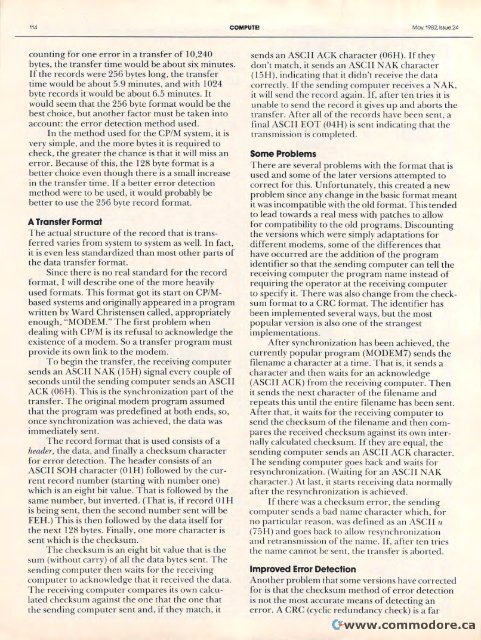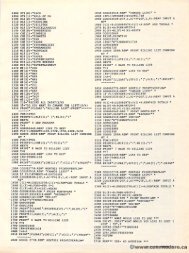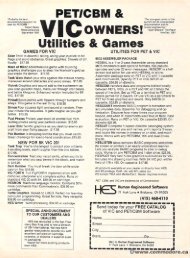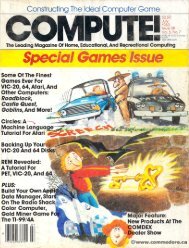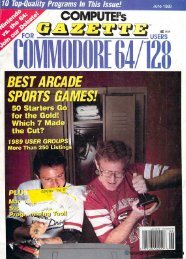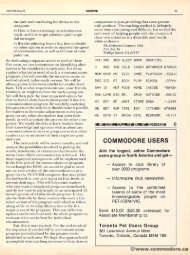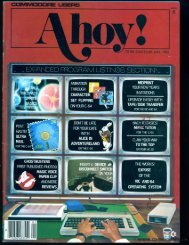Create successful ePaper yourself
Turn your PDF publications into a flip-book with our unique Google optimized e-Paper software.
11A 114 COMPUTE! Mov,W82.lssue May, 1982. Issue 24<br />
counting for one error in a transfer of 10,240<br />
bytes, the transfer time would be about six minutes.<br />
I If f the records were 256 bytes long, the transfer<br />
time would be about 5.9 minutes, and with 1024<br />
byte records it would be about 6.5 minutes. It<br />
would seem that the 256 byte format would be the<br />
best choice, but another factor must be taken into<br />
account: the error detection method used.<br />
In the method used for the CP/M system, it is<br />
very simple, and the more bytes it is required to<br />
check, the greater the chance is that it will miss an<br />
error. r. Because of this, the 128 byte format is a<br />
better choice even though there is a small increase<br />
in m the transfer time. Ifa a beller better error detection<br />
method were to be used, it would probably be<br />
beller better to use the 256 byte record format.<br />
A Transfer Format<br />
The actual structure re of the record that is transfen'ed<br />
ferred varies from system to system as well. In [n fact,<br />
it is even less standardized than most other pans parts of<br />
the data transfer format.<br />
Since there is no' real standard forr the record<br />
format, I will describe one of the more heavily<br />
used formats. This s format got its start on CP/M·<br />
CP/M-<br />
based systems and originally appeared in a program<br />
written by Ward Christensen called, appropriately<br />
enough, "MODEM." The first problem when<br />
dealingg with CP/M is its refusal to acknowledge the<br />
existence of a modem. So a transfer program must<br />
provide its own link to the modem.<br />
To begin the transfer, the receiving computer<br />
sends an ASCII NAK K (15H) signal every couple of<br />
seconds until unlilthe sending computer sends an ASCII<br />
ACK (06H). This is the synchronization part of the<br />
transfer. TheT original modem program assumed<br />
that the program was predefined at both ends, so,<br />
once synchronization ni was achieved, the data was<br />
immediately sent.<br />
The record format that is used consists of a<br />
header, the data, and finally y a checksum character<br />
for error detection. The header consists of an<br />
ASCII SOH character (OIH) (0 I followed by the current<br />
record number (starting with number one) o which is an eight bit value. That is followed owed by the<br />
same number, but inverted. (That is, if record 01H0 I H<br />
is being sent, then the second number sent will be<br />
FEH.) This is then followed by the data itself for<br />
the next 128 bytes. Finally, one more character is<br />
sent which is the checksum.<br />
The checksum is an eight bit value e that is the<br />
sum m (without carry) of alla the data bytes sent. The<br />
sending computer compuLer then waits for the receiving recei\' in g<br />
computer to acknowledge that it received the e data. daLa.<br />
The l ~ h e receiving g computer compares cOlllpares its own calculated<br />
checksum against the one that Lhat the one that Lhat<br />
the sending computer sent and, if they match, it<br />
sends an ASCII ACK character (06H).<br />
If they<br />
don't match, it sends an ASCII N NAKA K character<br />
((15H), indicating that it il didn't receive the data<br />
correcLl y. IfLhesending compute r receives a NA K.<br />
correctly. If the sending computer receives a NAK,<br />
it will send the record again. . I If, r. afLer after Len ten tries it is<br />
unable to send the record it gives up and aborts the<br />
unable to send the record it gives up and aborts the<br />
transfer. After all off the recordss have been sent, a<br />
final ASC II EOT (04 H) is sent indicating that the<br />
transmissio n is completed.<br />
final ASCII EOT (04H) is sent indicating that the<br />
transmission is completed.<br />
Some Problems<br />
There are several problems wi th the format that is<br />
There are several problems with the format that is<br />
used and some of the later versions attempted to<br />
correct for this. Unfortunately, this created a new<br />
problem since any change in the basic format meant<br />
it was incompatible with the old format. This tended<br />
to lead towards a real mess with patches to allow<br />
for compatibility to the old programs. Discounting<br />
the versions which were simply adaptations for<br />
the versions wh ich were simply adaptations for<br />
different modems, some of the differences that<br />
to specify it. T here was also change from the check<br />
different modems, some of the differences that<br />
have occurred are the addition of the program<br />
identifier so that the sending computer cann tell the<br />
receiving computer the progl'am program name instead of<br />
requiring the operator r at the receiving compuLer<br />
computer<br />
to specify it. There was also change from the check<br />
sum format to a CRC format. The identifier has<br />
been implemented several ways, but bUL the most<br />
popular version is also one of the sLrangesL<br />
strangest<br />
i implementations.<br />
III Lations.<br />
A After I' LeI' synchronization has been achieved, , the<br />
currently popular program (MODEM7) (MODEM?) sends the<br />
filename e nanle a character at a titlle time. . That is, it sends a<br />
character and then wails waits<br />
for an acknowledge<br />
(ASCII<br />
ACK) from the receiving g computer. compuLer. Then<br />
it iL sends the next character of the filename and<br />
repeats this until the entire filename has been sent.<br />
After AfLer that, thaL, it iL waits for the receiving computer to<br />
send the checksum of the filename and then Lhen compares<br />
the received checksum against againsL its iLs own inter<br />
nally calculated checksum. If they are equal, the<br />
nall y calculaLed checksum. If Lhey are equal, the<br />
sending computer se nds an ASC I [ ACK character.<br />
sending computer sends an ASCII ACK character.<br />
The sending computer puLer goes back and waits wailS for<br />
resynchronization. (Waiting (' Na iLing for i'or an ASCII NAK<br />
character.) Ler.) At AL last, lasL, it iL starts sLarts receiving g data normally<br />
y<br />
after the resynchronization ni zalion is achieved.<br />
If there was a checksum error, the sending<br />
If there was a checksum error, the sending<br />
computer sends a bad name character characLer which, for<br />
no particular panicular reason, , was defined as an ASCII // /I<br />
(75H) 1-1 ) and goes back to LU allow resynchronization<br />
ynchronizaLion<br />
and retransmission rCLranslllission of the name. If, I f. after ten len tries<br />
the name cannot not be sent, the transfer is aborted.<br />
Improved Error Detection<br />
Another AnoLher problem that Lhat some versions have corrected correcLed<br />
for fa r is that thaL the checksum method meLhod of error detection deLection<br />
is not t the e most accurate means ofo f detecting an<br />
error. A CRC (cyclic ic redundancy check) is a far


